Make a diagrammatic representation of cabon cyle
Step-by-Step Text Solution for the Carbon Cycle Diagram
1. Identify the Components of the Carbon Cycle:
- Carbon dioxide (CO₂) in the atmosphere.
- Sources of carbon dioxide: factory emissions, plant respiration, and animal respiration.
- Plants that utilize carbon dioxide for photosynthesis.
- The process of photosynthesis which produces oxygen and organic matter.
- Decay of plants and animals leading to the release of carbon back into the atmosphere.
2. Draw the Atmosphere:
- Start by drawing a cloud or a layer at the top of your diagram to represent the atmosphere where carbon dioxide is present.
3. Add Sources of Carbon Dioxide:
- Draw arrows pointing towards the atmosphere from:
- Factories (represent with a factory icon).
- Animals (represent with an animal icon).
- Plants (represent with a plant icon).
- Label these arrows as "Factory Emissions," "Animal Respiration," and "Plant Respiration."
4. Illustrate Photosynthesis:
- Draw a plant below the atmosphere.
- Draw an arrow from the atmosphere to the plant, labeled "CO₂ for Photosynthesis."
- Indicate sunlight with rays pointing towards the plant and label it "Sunlight."
- Show an arrow coming out of the plant labeled "O₂ Released."
5. Show Decay Process:
- Draw dead plants and animals near the plant.
- Use arrows pointing from the dead matter to the soil, labeled "Decay."
- Indicate that this decay leads to the formation of organic matter.
6. Return of Carbon to the Atmosphere:
- Draw an arrow from the soil back to the atmosphere, labeled "CO₂ Released from Decomposition."
7. Complete the Cycle:
- Ensure that the arrows create a loop, showing that carbon is continuously cycled through the ecosystem.
- Carbon dioxide (CO₂) in the atmosphere.
- Sources of carbon dioxide: factory emissions, plant respiration, and animal respiration.
- Plants that utilize carbon dioxide for photosynthesis.
- The process of photosynthesis which produces oxygen and organic matter.
- Decay of plants and animals leading to the release of carbon back into the atmosphere.
- Start by drawing a cloud or a layer at the top of your diagram to represent the atmosphere where carbon dioxide is present.
- Draw arrows pointing towards the atmosphere from:
- Factories (represent with a factory icon).
- Animals (represent with an animal icon).
- Plants (represent with a plant icon).
- Label these arrows as "Factory Emissions," "Animal Respiration," and "Plant Respiration."
- Draw a plant below the atmosphere.
- Draw an arrow from the atmosphere to the plant, labeled "CO₂ for Photosynthesis."
- Indicate sunlight with rays pointing towards the plant and label it "Sunlight."
- Show an arrow coming out of the plant labeled "O₂ Released."
- Draw dead plants and animals near the plant.
- Use arrows pointing from the dead matter to the soil, labeled "Decay."
- Indicate that this decay leads to the formation of organic matter.
- Draw an arrow from the soil back to the atmosphere, labeled "CO₂ Released from Decomposition."
- Ensure that the arrows create a loop, showing that carbon is continuously cycled through the ecosystem.
Topper's Solved these Questions
- PHOTOSYNTHESISBOOK - ICSECHAPTER - PHOTOSYNTHESISEXERCISE - CHOOSE THE CORRECT ANSWER
14 Videos
- PHOTOSYNTHESISBOOK - ICSECHAPTER - PHOTOSYNTHESISEXERCISE - COMPLETE THE FOLLOWING STATEMENTS
30 Videos
- NERVOUS SYSTEM BOOK - ICSECHAPTER - NERVOUS SYSTEM EXERCISE - REVIEW QUESTIONS (Find the odd one out: )
10 Videos
- POLLUTION BOOK - ICSECHAPTER - POLLUTION EXERCISE - REVIEW OLUESTIONS
55 Videos
Similar Questions
The given figure is a diagrammatic representation of response of organisms to abiotic factors. What do A, B and C represent respectively?
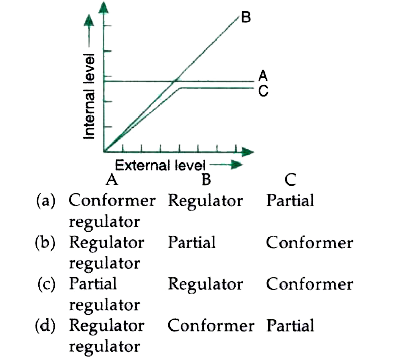
View SolutionGiven below is a diagrammatic representation of a certain part of the process of circulation of blood in man. Study the same and then answer the questions that follow:
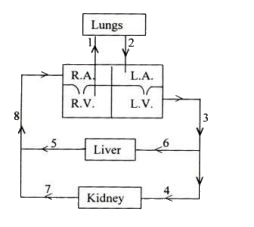
Name the parts labelled 1, 2, 4 and 6.
View Solution
Knowledge Check
Refer to the given diagrammatic representation of an electron micrograph of a section of chloroplast and answer the
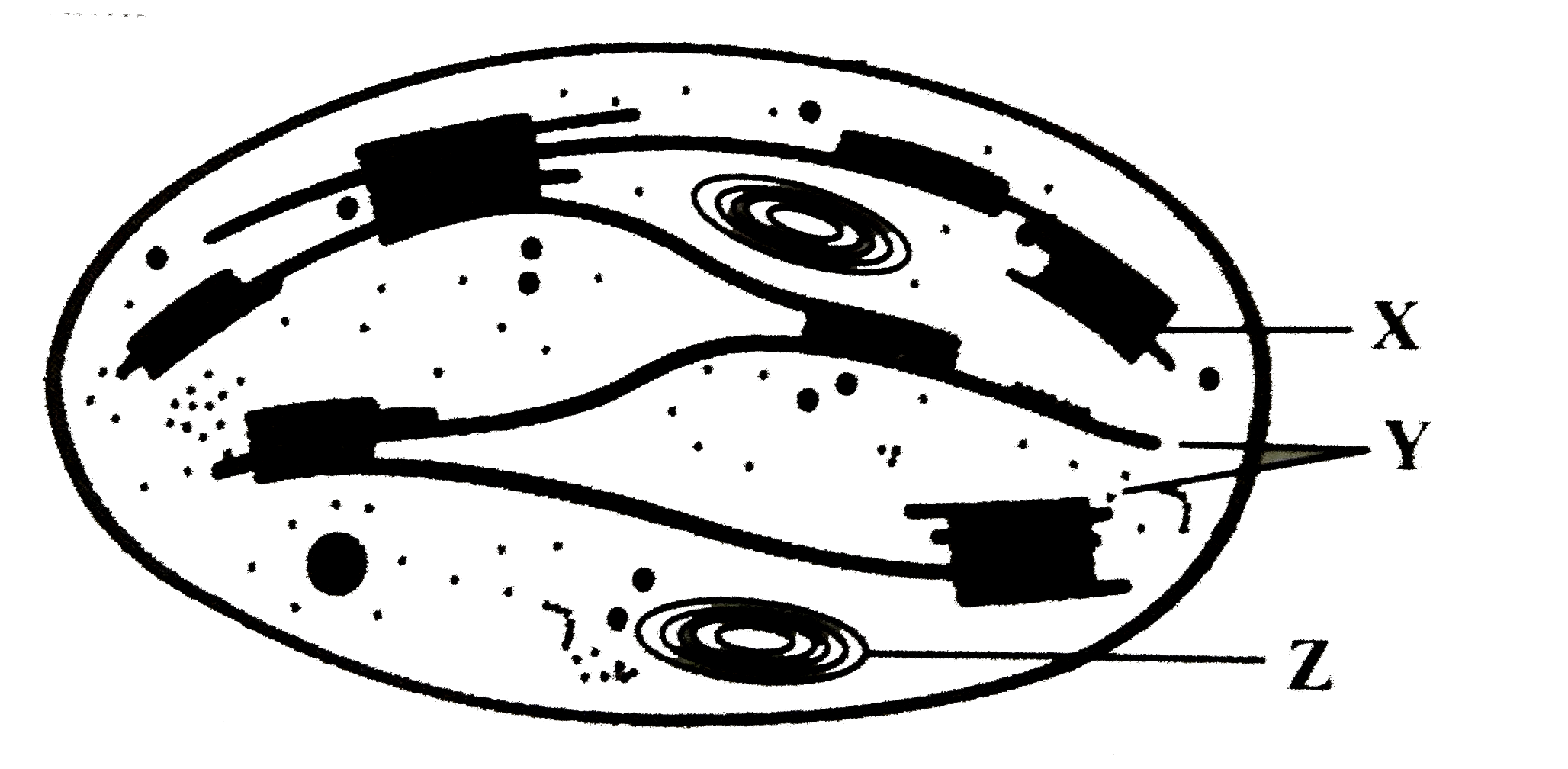 Select the option that correct identifes X,Y and Z.AXYZStromaGranaChloroplast DNABXYZStromaGranaStarch granuleCXYZGranaStromaStarch granuleDXYZGranaStromaChloroplast DNA
Select the option that correct identifes X,Y and Z.AXYZStromaGranaChloroplast DNABXYZStromaGranaStarch granuleCXYZGranaStromaStarch granuleDXYZGranaStromaChloroplast DNARefer to the given diagrammatic representation of an electron micrograph of a section of chloroplast and answer the
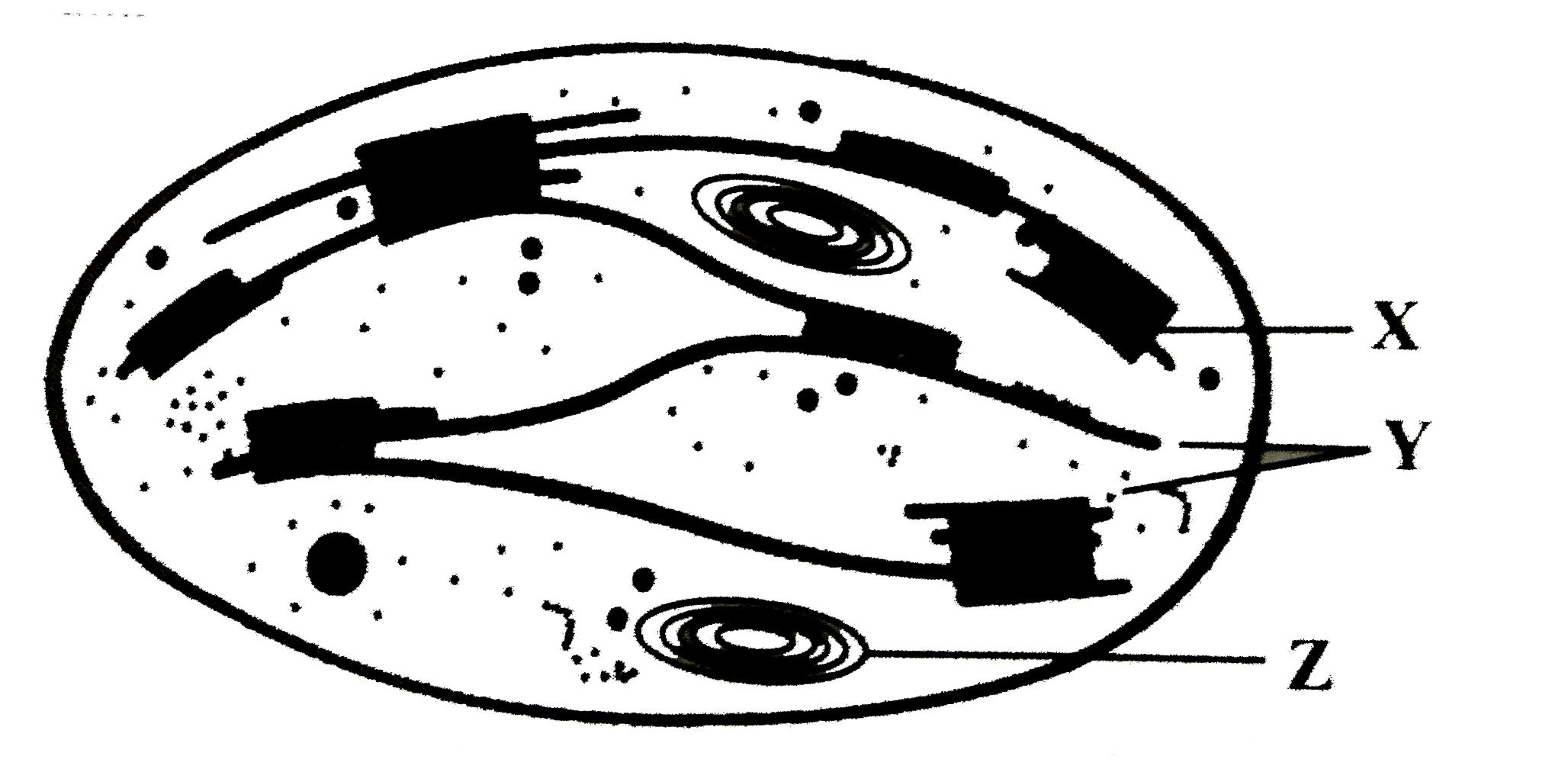
Select the option which correctly depicts the functions of parts X,Y and ZAXYZDark reactionLight reactionCytoplasmic inheritanceBXYZLight reactionCarbohydrate synthesisCarbohydrate storageCXYZLight reactionCarbohydrate storageCarbohydrate synthesisDXYZCarbohydrate synthesisCarboyhydrate storageCytoplasmic inheritance
Given below is a diagrammatic representation of a certain part of the process of circulation of blood in man. Study the same and then answer the questions that follow:
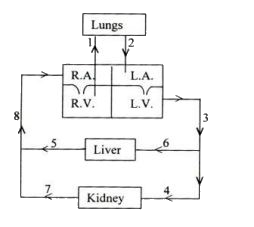
Draw a neat, labelled diagram of the cross sectional view of the blood vessel numbered 3.
View SolutionGiven below is a diagrammatic representation of a certain part of the process of circulation of blood in man. Study the same and then answer the questions that follow:

Mention two structural differences between blood vessels ‘3’ and ‘8’.
View SolutionGiven below is a diagrammatic representation of a certain part of the process of circulation of blood in man. Study the same and then answer the questions that follow :
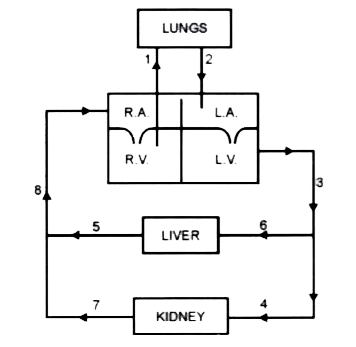
Name the parts labelled 1, 2, 4 and 6
View SolutionGiven below is a diagrammatic representation of a certain part of the process of circulation of blood in man. Study the same and then answer the questions that follow :
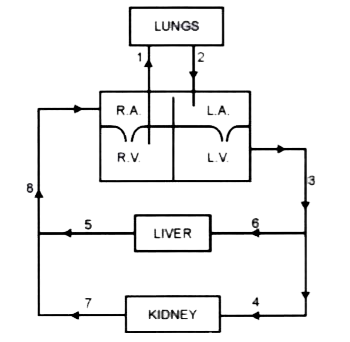
Draw a neat, labelled diagram of the cross sectional view of the blood vessel numbered 3.
View SolutionGiven below is a diagrammatic representation of a certain part of the process of circulation of blood in man. Study the same and then answer the questions that follow :
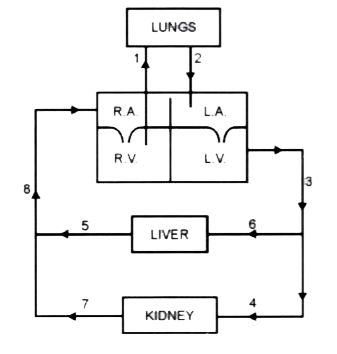
Mention two structural differences between blood vessels '3' and '8
View SolutionGiven below is a diagrammatic representation of a certain part of the process of circulation of blood in man. Study the same and then answer the questions that follow:

Give the number and name of the vessel which contains the maximum amount of urea a few hours after a protein rich meal.
View Solution
